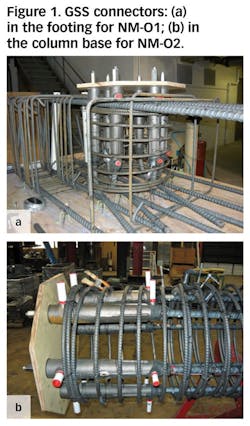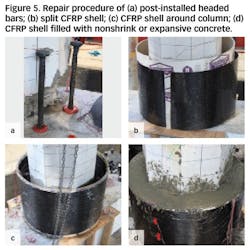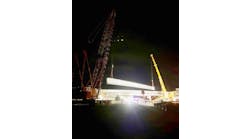By: M.J. Ameli, Joel Parks, Dylan Brown and Chris Pantelides
In recent years, accelerated bridge construction (ABC) has gained attention within regions of high seismicity.
Prefabrication of bridge structural components is an effective ABC method under the category of prefabricated bridge elements and systems (PBES) promoted by the Federal Highway Administration (FHWA). Connections between such precast components play an important role in the overall seismic performance of bridges. Grouted Splice Sleeve (GSS) connection has been frequently used in non-seismic regions, because it offers ease of construction and acceleration of the overall construction process. In this connection type, each reinforcing bar in connecting precast components is spliced by means of a mechanical splicing device which is cast within one of the adjoining components.
This article describes a research study which investigates the performance of two precast bridge piers with GSS connectors under simulated seismic loads. Furthermore, a rapid repair strategy which was implemented to re-establish the structural integrity of the two severely damaged columns is discussed. The repair uses materials that are available and easy to install, including epoxy-anchored headed bars, carbon fiber reinforced polymer (CFRP) sheets and non-shrink or expansive concrete. The result is a cost-effective, corrosion-resistant, rapid repair method which can be installed within a few days. Due to the robust nature of the repair method, it is a suitable option for columns of varying damage states, including columns with buckled or fractured longitudinal bars.
Testing it out
The half-scale test subassemblies were designed according to the AASHTO Guide Specifications for conventional columns with monolithic details. The design was then adjusted to accommodate the GSS connectors as shown in Figure 1(a) with GSS connectors in the footing (NM-O1) and Figure 1(b) with GSS connectors in the column base (NM-O2). The columns had a 21-in. octagonal cross-section and a height equal to 102 in. The columns were reinforced longitudinally with six No. 8 bars and had a No. 4 spiral reinforcement spaced at 2.5 in. A dowel bar length equal to 7 in. on average, for No. 8 main reinforcing bars, protruded from the column base and the footing for NM-O1 and NM-O2, respectively, as shown in Figure 2. The footing dowel bars of NM-O2 were debonded from the surrounding concrete to achieve a better strain distribution adjacent to the column-to-footing interface. Grouting operation was carried out by pouring a high-strength grout into the wide end opening of the GSS connectors before setting the column down for NM-O1; this is referred to as pre-grout operation. For NM-O2, a post-grout operation was performed in which the grout was pumped into the bottom nozzle of each GSS connector. Figure 3 shows specimen NM-O1 attached to the testing frame before the application of lateral displacement amplitudes to the column top. A quasi-static cyclic displacement history was applied to the columns 96 in. above the footing to simulate the cyclic effects of seismic actions. Both test subassemblies had a ductile performance up to a 7% and 8% drift ratio for NM-O1 and NM-O2, respectively, when an extreme reinforcing bar fractured for both specimens; this implies a large displacement capacity for both specimens. Figure 4 shows the damage at the column-to-footing interface where extensive spalling and cracking occurred, especially for NM-O1, in the plastic hinge region. Both specimens experienced large flexural cracking, which extended to 14 in. away from the footing interface. At failure of the specimens, the lateral load capacity dropped well below 80% of the ultimate load. The reserve lateral load capacity of the columns after testing ranged from 44% to 65% of the maximum lateral load capacity.
Findings from the experiments on the two precast subassemblies indicated that columns connected using GSS connectors concentrate the column damage and decrease the effective plastic hinge length compared to traditional monolithic construction, especially if GSS connectors are incorporated in the column ends. These damage characteristics are advantageous for repair purposes, leaving a relatively undamaged column section for plastic hinge relocation. Hence, a repair method was developed to strengthen the original plastic hinge region and relocate the plastic hinge to a column section adjacent to the repair. This was done by increasing the 21-in. octagonal cross section to a reinforced 30-in.-diam. circular cross section; the latter was constructed by post-installing epoxy-anchored headed bars for additional tensile force transfer and subsequently filling a CFRP shell with non-shrink or expansive concrete. The first step in the repair procedure was to create a prefabricated CFRP shell. A single layer of 18-in.-wide CFRP sheet impregnated with epoxy was wrapped and cured around a 30-in.-diam. sonotube to create the proper shape.
While the CFRP shell was curing, the holes for the headed bars were core-drilled into the footing and the headed bars were epoxy-anchored into place around the column, as shown in Figure 5(a). After the CFRP shell had cured, it was split in two half-cylinders and brought around the column as shown in Figure 5(b). The splitting and splicing of the first CFRP shell layer was performed to better simulate how the repair would be constructed in the field. A circular shell cannot be lowered over a column since the latter is connected to a footing and pier cap. The sonotube inside the shell in Figure 5(b) was used to ensure that the shell maintained its shape, while the additional layers of CFRP were applied and was subsequently removed once all CFRP layers had cured. A 12-in. by 18-in. piece of CFRP sheet impregnated with epoxy was used to splice the two halves of the CFRP shell on both sides. Once the first layer of the CFRP shell was spliced, three additional CFRP layers were added as shown in Figure 5(c). Each layer was 100 in. long by 18 in. wide, with a 6-in. overlap for each layer. This was the last step in completing the construction of the CFRP shell, which acted as stay-in-place formwork for the repair concrete. Once the CFRP shell had fully cured, nonshrink or expansive concrete was added to the space between the column and CFRP shell as shown in Figure 5(d).
Since the damage states of both precast specimens prior to repair were similar, the same repair design was used. The only difference in the repair was the type of concrete used to fill the void between the original 21-in. octagonal column and the 30-in.-diam. by 18-in.-high CFRP shell. This concrete, referred to as the repair concrete, was designed as nonshrink concrete for the repair of NM-O1, which is named NM-R1 and as expansive concrete for the repair of NM-O2, which is referred to as NM-R2. The use of expansive instead of nonshrink concrete converts the CFRP shell from providing passive to active confinement.
The strength and displacement capacity of the damaged bridge columns were restored by achieving the same displacement drift and lateral load as the original precast specimens. The successful plastic hinge relocation for NM-R1 is shown in Figure 6. Specimen NM-R1 achieved an 18% larger lateral load than NM-O1 and specimen NM-R2 achieved a 28% larger lateral load than NM-O2. From these results, the repair was able to restore the assembly to a performance level similar to the original condition.
Conclusion
Based on the overall performance of the repair in the half-scale experiments, this is a viable repair technique for damaged columns in seismic regions. In the present case, initial damage of the columns was severe, therefore the method is deemed to be robust and is applicable to columns with varying damage states. The repair technique is rapid and thus satisfies the requirements of ABC.
About The Author: Ameli and Parks are graduate research assistants at the University of Utah. Brown is a bridge engineer with Michael Baker International. Pantelides is a professor at the University of Utah.









